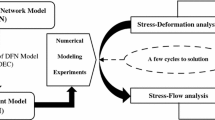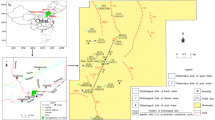Abstract
This paper highlights certain aspects of glacial impact on groundwater flow and rock mechanics, of particular interest in future scenarios for the geological disposal of nuclear waste. The investigation took the form of a generic exercise based on conditions at the underground research facility in Whiteshell, Canada. The site scale model domain boundaries were set up based on a number of major deformation zones. The surface boundary conditions comprised a transient ice sheet load and related hydraulic heads, generated by meltwater. It has thus been possible to compare glacial impact in relation to present-day climatological conditions. The main issues in the investigation were to evaluate the groundwater flow regime and the pre-requisites for underground jacking as well as shearing according to the prescribed geoscientific properties of a benchmark protocol. Special attention has been devoted to a solution to the hydromechanical (HM) problem (1) with or without process coupling, (2) with or without a transient approach, and (3) considering a two- or three-dimensional mode. The study underlines the need for transient analyses in 3D of these coupled phenomena.
Résumé
L’article met en lumière certains aspects d’un impact glaciaire sur l’écoulement des eaux souterraines et le comportement mécanique des roches, avec un intérêt particulier pour l’étude de scénarios relatifs au stockage de déchets radioactifs en formations géologiques. La recherche a pris la forme d’un exercice générique basé sur les conditions du laboratoire souterrain de Whiteshell, au Canada. Les conditions aux limites du modèle ont pris en compte les différentes zones de déformation majeure du site. Les conditions aux limites de surface considèrent le chargement transitoire d’une calotte glaciaire et les charges hydrauliques correspondantes, générées par les eaux de fonte. Ainsi, il a été possible de comparer l’impact glaciaire avec les conditions climatiques actuelles. Les principaux thèmes de la recherche portaient sur l’évaluation du régime des eaux souterraines et les facteurs de prédisposition au claquage hydraulique et au cisaillement, suivant les propriétés géotechniques fournies par un protocole d’exercice normalisé. Une attention particulière a été portée sur une solution au problème hydromécanique (HM) (i) avec ou sans couplage des processus, (ii) avec ou sans approche transitoire et (iii) considérant une analyse à deux ou trois dimensions. L’étude souligne la nécessité de réaliser des analyses en mode transitoire, à trois dimensions, pour ces phénomènes couplés.













Similar content being viewed by others
References
Arnold N, Sharp M (1992) Influence of glacier hydrology on the dynamics of a large Quaternary ice sheet. J Quat Sci 7(2):109–124
Bäckblom G, Munier R (2002) Effects of earthquakes on the deep repository for spent fuel in Sweden based on case studies and preliminary model results. SKB TR-02–24, Swedish Nuclear Fuel and Waste Management Company, Stockholm, Sweden
Boulton GS, Dobbie KE (1993) Consolidation of sediments by glaciers: relation between sediment geotechnics, glacier dynamics and subglacial groundwater flow. J Glaciol 39(131):26–44
Boulton GS, Payne A (1994) Mid-latitude ice sheet through the last glacial cycle: glaciological and geological reconstruction. Long-term climatic variations. NATO ASI Ser I 22:177–212
Boulton GS, Caban PE, van Gijssel K, Leijnse A, Punkari M, van Weert FHA (1996) The impact of glaciation on the groundwater regime of Northwest Europe. Global Planet Change 12:397–413
Boulton GS, Chan T, Christiansson R, Ericsson LO, Hartikainen J, Jenssen MR, Stanchell FW, Wallroth T (2004) Thermo-hydro-mechanical (T-H-M) impacts of glaciation and implications for deep geological disposal of nuclear waste. In: Coupled thermo-hydro-mechanical–chemical processes in GEO-systems: fundamentals, modelling, experiments and applications, vol 2. Elsevier Geo-Engineering Book Series, Amsterdam, pp 299–304, ISBN 0-08-044525-X
Boulton GS, Slot T, Blessing K, Glasbergen P, Leijnse T, van Gijssel K (1993) Deep circulation of groundwater in overpressured subglacial aquifers and its geological consequences. Quat Sci Rev 12(9):739–745
Boulton GS, Zatsepin S, Maillot B (2001) Analysis of groundwater flow beneath ice sheets, SKB TR-01-06. Swedish Nuclear Fuel and Waste Management Company, Stockholm
Bour O, Davy P (1999) Clustering and size distributions of fault patterns: theory and measurements. Geophys Res Lett 26(13):2001–2004
Bour O, Davy P (1998) On the connectivity of three-dimensional fault networks. Water Resour Res 34(10):2611–2622
Chan T, Christiansson R, Boulton GS, Ericsson LO, Hartikainen J, Jensen MR, Mas Ivars D, Stanchell FW, Vidstrand P, Wallroth T (2005) DECOVALEX III, BMT3/BENCHPAR WP4. Report of BMT3/WP4—the thermo-hydro-mechanical responses to a glacial cycle and their potential implications for a deep geological disposal of nuclear fuel waste in a fractured crystalline rock mass. SKI report 2005:28, Swedish Nuclear Power Inspectorate, Stockholm, See CD-ROM attachment entitled, DECOVALEX III, BMT3/BENCHPAR WP4: The THM conditions during the dynamics of a glaciation cycle: a synthetic case based mainly on simplified data from the Whiteshell site
Chan T, O’Conner PA, Stanchell FW (1998) Finite-element modelling of effects of past and future glaciation on the host rock of a used fuel waste vault. Report No. 06819-REP-01200-0020 R00, Ontario Hydro (Ontario Power Generation), Toronto
Darcel C, Bour O, Davy P, de Dreuzy JR (2003) Connectivity properties of two-dimensional fracture networks with stochastic fractal correlation. Water Resour Res 39(10)
Ericsson LO, Boulton GS, Wallroth T (1994) Analysis of long-term geological and hydrogeological changes in the Swedish programme for final disposal of nuclear waste. OECD documents. Disposal of radioactive waste—characterisation of long-term geological changes for disposal sites. In: Proceedings of an NEA Workshop, Paris, France, 19–21 September. Nuclear Energy Agency, Paris
Flowers GE, Clarke GKC (2002) A multicomponent coupled model of glacier hydrology (part 1 and Part 2). J Geophys Res 107(B11):2287
Follin S, Svensson U (2003) On the role of mesh discretisation and salinity for the occurrence of local flow cells, Results from a regional-scale groundwater flow model of Östra Götaland. SKB R-03-23. Swedish Nuclear Fuel and Waste Management Company, Stockholm
Fowler AC, Walder JS (1993) Creep closure of channels in deforming subglacial till. Proc Roy Soc Lond Ser A 441:17–31
Freeze RA, Witherspoon PA (1967) Theoretical analysis of regional groundwater flow. 2. Effect of water table configuration and subsurface permeability variation. Water Resour Res 3:623–634
French HM (1996) The periglacial environment, 2nd edn, Addison Wesley Longman Limited, Reading. ISBN 0-582-30536-5
Haldorsen S, Heim M (1999) An arctic groundwater system and its dependence upon climatic change: An example from Svalberg. Permafrost Periglacial Processes 10(2):137–149
Hansson H, Stephansson O, Shen B (1995) Far-field rock mechanics modelling for nuclear waste disposal. SKI Technical Report 95:40. Swedish Nuclear Power Inspectorate, Stockholm
Hutri K-L, Antikainen J (2002) Modelling of bedrock response to glacial loading at the Olkiluoto site, Finland. Eng Geol 67:39–49
McEwan T, de Marsily Gh (1991) The potential significance of permafrost to the behaviour of a deep radioactive waste repository. SKI Technical Report 91:8. Swedish Nuclear Power Inspectorate, Stockholm
Näslund JO, Rodhe L, Fastook JL, Holmlund P (2003) New ways of studying ice sheet flow directions and glacial erosion by computer modeling—examples from Fennoscandia. Quat Sci Rev 22:245–258
Nguyen TS, Polischuk V, Selvadurai APS (1993) Effects of glaciation on the nuclear fuel waste repository. In: Proceedings of the 46th annual Canadian Geotechnical Conference, Saskatoon, Saskatchewan, Canada
Nye JF (1973) Water at the bed of a glacier. IAHS Publ 95:189–194
Olsson R, Barton N (2001) An improved model for hydromechanical coupling during shearing of rock joints. Int J Rock Mech Mining Sci 38(3):317–329
Pusch R, Börgesson L, Knutsson S (1990) Origin of silty fracture fillings in crystalline bedrock. Geologiska Föreningens i Stockholm Förhandlingar 112:209–213
Röthlisberger H (1972) Water pressures in intra- and subglacial channels. J Glaciol 11:177–203
SKB (2005) Preliminary site description. Forsmark area—version 1.2, SKB R-05-08
Talbot CJ (1990) Problems posed to a bedrock radwaste repository by gently dipping fracture zones. Geologiska Föreningens i Stockholm Förhandlingar 112:355–359
Talbot CJ (1999) Ice age and nuclear waste isolation. Eng Geol 52:177–192
Tóth J (1963) A theoretical analysis of groundwater flow in small drainage basins. J Geophys Res 68(10):4795–4812
van Weert FHA, van Gijssel K, Leijnse A, Boulton GS (1997) The effect of Pleistocene glaciations on the geohydrological system of Northwest Europe. J Hydrol 195:137–159
Vidstrand P (2001) Comparison of upscaling methods to estimate hydraulic conductivity. Ground Water 39(3)
Vidstrand P, Wallroth T, Ericsson LO, Hernelind J (2003) Benchpar WP4/Decovalex III BMT3, Phase III Progress Report. Publ B511. Department of Geology, Chalmers University of Technology, Göteborg, Sweden. ISSN 1104-9847
Voss CI, Andersson J (1993) Regional flow in the Baltic shield during Holocene coastal regression. Ground Water 31(6):986–1006
Wallroth T, Ericsson LO, Hernelind J (2003) Benchpar WP4/Decovalex III BMT3, Phase II Progress Report. Publ B507. Department of Geology, Chalmers University of Technology, Göteborg, Sweden. ISSN 1104–9847
Weertman J (1964) The theory of glacier sliding. J Glaciol 5:287–303
Acknowledgments
The authors acknowledge the work of colleagues Rolf Christiansson at SKB and Jan Hernelind at FemTech as well as fruitful discussions with the other modelling teams involved in the project. The work presented here is funded by SKB and EC, and their financial contributions are greatly appreciated.
Author information
Authors and Affiliations
Corresponding author
Rights and permissions
About this article
Cite this article
Vidstrand, P., Wallroth, T. & Ericsson, L.O. Coupled HM effects in a crystalline rock mass due to glaciation: indicative results from groundwater flow regimes and stresses from an FEM study. Bull Eng Geol Environ 67, 187–197 (2008). https://doi.org/10.1007/s10064-008-0123-8
Received:
Accepted:
Published:
Issue Date:
DOI: https://doi.org/10.1007/s10064-008-0123-8
Keywords
- Geological disposal
- Nuclear waste
- Glacial impact
- Benchmark protocole
- Groundwater flow regime
- Coupled hydromechanical phenomena




